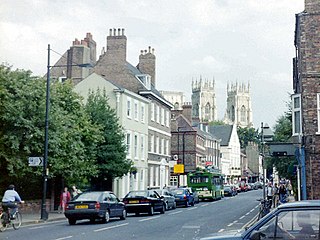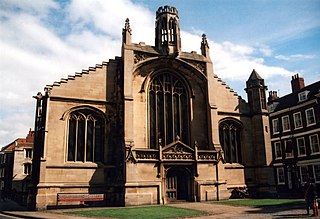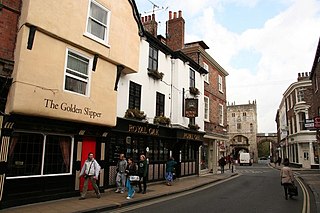
Bootham is a street in the city of York, in England, leading north out of the city centre. It is also the name of the small district surrounding the street.

St Michael le Belfrey is an Anglican church in York, England. It is situated at the junction of High Petergate and Minster Yard, directly opposite York Minster, in the centre of the city.
York had around 45 parish churches in 1300. Twenty survive, in whole or in part, a number surpassed in England only by Norwich, and 12 are used for worship. This article consists of a list of medieval churches which still exist in whole or in part, and a list of medieval churches which are known to have existed in the past but have been completely demolished.

Stonegate is a street in the city centre of York, in England, one of the streets most visited by tourists. Most of the buildings along the street are listed, meaning they are of national importance due to their architecture or history.

Coney Street is a major shopping street in the city centre of York, in England. The street runs north-west from the junction of Spurriergate and Market Street, to St Helen's Square. New Street leads off the north-east side of the street, as does a snickelway leading to the Judges Court hotel, while several snickelways lead from the south-west side down to the River Ouse, including Blanshard's Lane, and paths leading to City Screen.

Blake Street is a road in the city centre of York, in England.

Walmgate is a street in the city centre of York, in England. During the Medieval period, the street was the site of a seafish and cattle market. Walmgate Bar was involved in the Siege of York in 1644, during the First English Civil War. During the 20th century, many of the older buildings were cleared away and newer structures put up.

Duncombe Place is a street in the city centre of York, in England.

Goodramgate is a street in the city centre of York, in England.

St Leonard's Place is a street in the city centre of York, in England.

Ousegate is a street in the city centre of York, in England. It is divided into High Ousegate and Low Ousegate.

Marygate is a street in York, England, running just north of the city centre. Built in the Middle Ages, it gets its name from St Mary's Abbey and the Viking word "gata," meaning street. The area where the street lies was outside the walls of the Roman city of Eboracum, and represented the northern limit of the settlement; to the north, the land was used only for burials. The street runs south-west, from Bootham, down to the River Ouse.

Grape Lane is a street in the city centre of York, in England.

Swinegate is a street in the city centre of York, in England.

Minster Yard is a street in the city centre of York, England. It runs along the southern, eastern and northeastern sides of York Minster, for which it is named.

Precentor's Court is an historic street in the English city of York. Although certainly in existence by 1313, the street does not appear on a map until 1610, and it is not given a name until 1722. It was given its current name exactly a century later.

Minster Gates is a north–south running street in the city centre of York, England, connecting Minster Yard and High Petergate. All of its buildings are listed, many dating to the 18th century, although the street is significantly older.

54, 56, and 58 Stonegate is a grade II* listed mediaeval terrace in the city centre of York, in England.

33–35 High Petergate is a Mediaeval building in the city centre of York, in England.

2–2A High Petergate is an historic building in York, England. A Grade II listed building, it stands adjacent to Bootham Bar at the opposite end of High Petergate from York Minster. It was built around 1840; a shopfront was added the following century.






















